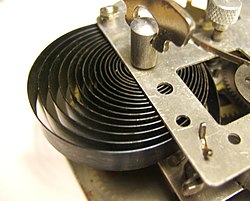発条
Appearance
See also: 發條
Japanese
[edit]Etymology 1
[edit]
| Kanji in this term | |
|---|---|
| 発 | 条 |
| ばね | |
| Grade: 3 | Grade: 5 |
| jukujikun | |
| Alternative spellings |
|---|
| 發條 (kyūjitai) 撥条 (rare) 弾機 (rare) |
Shift from 跳ね (hane, “jumping, springing”), the 連用形 (ren'yōkei, “stem or continuative form”) of the verb 跳ねる (haneru, “to jump, to spring”)..[1][2][3]
First cited to 1888.[3]
The kanji are jukujikun and not commonly seen in modern usage. This term is usually written in hiragana.
Pronunciation
[edit]Noun
[edit]- [from 1888] spring (device made of flexible material)
- [from 1897] (by extension) springiness, bounce, resilience (such as physical or emotional)
- Synonym: 弾力性 (danryokusei)
- 弾力強き心の二郎は...
- bane tsuyoki kokoro no Jirō ha
- Jirō of the heart of strong resilience → Jirō of the resilient heart...
- [date uncertain] (uncommon, possibly dated, figurative) a springboard, spark, or catalyst leading to some other change
- 住民運動がばねとなって基地が撤去された
- jūmin undō ga bane to natte kichi ga tekkyo sareta
- With the protests by residents as the catalyst, the base was shut down
- 住民運動がばねとなって基地が撤去された
Etymology 2
[edit]
| Kanji in this term | |
|---|---|
| 発 | 条 |
| ぜんまい | |
| Grade: 3 | Grade: 5 |
| jukujikun | |
| Alternative spellings |
|---|
| 發條 (kyūjitai) 撥条 (uncommon) |
Shift in meaning from 薇 (zenmai, “Japanese flowering fern”), from the visual resemblance of a coiled clockwork spring to a coiled fern fiddlehead.[5]
First cited to 1732.[5]
Pronunciation
[edit]Noun
[edit]- [from 1732] spring (device made of flexible material), specifically the spiral torsion kind commonly used in clockwork that is coiled into a disc shape like a fern fiddlehead
- [from 1812] (possibly dated) Short for 発条仕掛 (zenmai-jikake, “clockwork mechanism, clockwork”).
Derived terms
[edit]Etymology 3
[edit]
| Kanji in this term | |
|---|---|
| 発 | 条 |
| はつ Grade: 3 |
じょう Grade: 5 |
| kan'on | goon |
| Alternative spelling |
|---|
| 發條 (kyūjitai) |
Appears to be a shift in reading of 発条 (bane), adopting the common on'yomi of the individual kanji characters. Possibly a learned borrowing from Chinese 發條 / 发条 (fātiáo).
First cited to 1879.[7]
Pronunciation
[edit]- (Tokyo) はつじょー [hàtsújóó] (Heiban – [0])[2][4][6]
- (Tokyo) はつじょー [hàtsúꜜjòò] (Nakadaka – [2])[2][4][6]
- IPA(key): [ha̠t͡sɨʑo̞ː]
Noun
[edit]発条 • (hatsujō) ←はつでう (fatudeu)?
- [from 1879] spring (device made of flexible material)
- [from 1961] a motivation or catalyst leading to some other change
References
[edit]- ^ Shinmura, Izuru, editor (1998), 広辞苑 [Kōjien] (in Japanese), Fifth edition, Tokyo: Iwanami Shoten, →ISBN
- ↑ 2.0 2.1 2.2 2.3 2.4 Matsumura, Akira, editor (2006), 大辞林 [Daijirin] (in Japanese), Third edition, Tokyo: Sanseidō, →ISBN
- ↑ 3.0 3.1 “発条・撥条・弾機”, in 日本国語大辞典 [Nihon Kokugo Daijiten][1] (in Japanese), concise edition, Tokyo: Shogakukan, 2006
- ↑ 4.0 4.1 4.2 4.3 NHK Broadcasting Culture Research Institute, editor (1998), NHK日本語発音アクセント辞典 [NHK Japanese Pronunciation Accent Dictionary] (in Japanese), Tokyo: NHK Publishing, Inc., →ISBN
- ↑ 5.0 5.1 “発条・撥条”, in 日本国語大辞典 [Nihon Kokugo Daijiten][2] (in Japanese), concise edition, Tokyo: Shogakukan, 2006
- ↑ 6.0 6.1 6.2 Kindaichi, Kyōsuke et al., editors (1997), 新明解国語辞典 [Shin Meikai Kokugo Jiten] (in Japanese), Fifth edition, Tokyo: Sanseidō, →ISBN
- ^ “発条”, in 日本国語大辞典 [Nihon Kokugo Daijiten][3] (in Japanese), concise edition, Tokyo: Shogakukan, 2006
Categories:
- Japanese terms spelled with 発
- Japanese terms spelled with 条
- Japanese terms read with jukujikun
- Japanese terms with IPA pronunciation
- Japanese lemmas
- Japanese nouns
- Japanese terms with multiple readings
- Japanese terms spelled with third grade kanji
- Japanese terms spelled with fifth grade kanji
- Japanese terms with 2 kanji
- Japanese terms with usage examples
- Japanese terms with uncommon senses
- Japanese dated terms
- Japanese short forms
- Japanese terms spelled with 発 read as はつ
- Japanese terms spelled with 条 read as じょう
- Japanese terms read with on'yomi
- Japanese terms borrowed from Chinese
- Japanese learned borrowings from Chinese
- Japanese terms derived from Chinese
- Japanese terms with 撥 replaced by daiyōji 発



